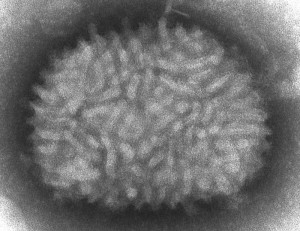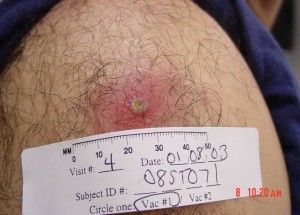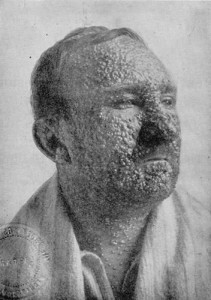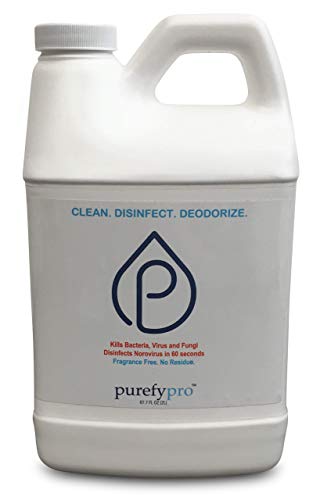The vaccinia virus was once very common in the United States and then for many years it became essentially unheard of. Now, the occurrence of vaccinia infection is increasing once again, although still rare, it is now known to occur primarily in the families and intimate contacts of members of the military and other emergency response personnel. Unlike most any other appearance of an infectious agent, vaccinia occurs only because it was, at some point and to at least some people, intentionally introduced, and that only because of political changes in the world today. The problematic infections are secondary ones among those never intended to be exposed, and those infections can be life-threatening among some individuals. Stumped? Vaccinia is closely related to one of the most dreaded viral killers in all of human history: smallpox.
Vaccinia Basics
The vaccinia virus is the one on which one of the most successful vaccines of all time was built; the smallpox vaccine. The disease smallpox is caused by the variola virus. Inoculation with the variola virus itself was felt to be far too dangerous and in the beginning of the vaccine age the concept of weakening or killing a virus prior to inoculation was not understood or developed. It was known, however, that in the case of smallpox, those previously infected with a similar virus, often cowpox, but other viruses as well, were generally protected against subsequent outbreaks of smallpox. Dr. Edward Jenner in England, in the 18th century, conducted his now famous experiments in cowpox inoculation among children not previously exposed to smallpox and the vaccine concept, which has saved literally thousands of lives, was born.
Immunity Against, and the Eradication of, Smallpox
Perhaps fortunately, the smallpox virus is a member of the Orthopoxvirididae, or Orthopox family of viruses, and these viruses are not only large, but also highly cross-reactive immunologically, which simply means that infection with one member of the Orthopox family tends to confer immunity from infection with other members of the same family. Because infection with vaccinia tends to be mild and not life threatening, the risks of such an infection are generally far outweighed by the very substantial risks of infection with smallpox. Smallpox vaccination in the United States began on a large scale in the 1930s with the development of a successful vaccine, the first large scale manufacturing effort of such a type in the world. Eventually, because of several factors rather unique to smallpox infection, the concerted efforts of the world, coordinated through the World Health Organization, succeeded in eradicating smallpox from the natural world. The last known natural case occurred in Somalia in 1977 and by 1980 the disease of smallpox was declared eradicated. The United States had officially ended large scale general vaccination in 1972, reserving vaccination for those very few people who had potential contact with the variola virus in laboratory work.
The Lingering Risk
Today, the variola virus is only known to exist in government laboratories in the United States, Great Britain, and Russia. These virus samples are maintained for research and as a basis for renewed vaccine production should that ever become necessary. In the late 20th Century there were concerns following the breakup of the former Soviet Union that control of the smallpox samples held there might have been compromised and that it would become possible for other nations with ill intention towards the West, or even non-governmental terrorist groups, might obtain smallpox samples and use them as biological weapons since the viability of such attacks had been proven, and weaponized stockpiles of variola virus had been developed by both the Western nations and the Soviets. Due to this concern, in 2002 the United States government once again authorized the general vaccination of members of the military and first responders. Due to serious complications including previously unknown cardiomyopathy, a weakening of the heart muscle that could prove fatal, vaccination of first responders was ended, but the general vaccination of the military and some civilian military contractors continues to this day.
Household Vaccinia Transmission
Because the vaccinia virus used in the smallpox vaccine is a live virus, secondary transmission to unvaccinated people who have intimate, sexual, casual household, and/or mother-to-child through breastfeeding contact has occurred. Normally, these infections are mild, but in very young children, those with dermatological conditions, or those with weakened immune systems due to disease or certain medications used to treat certain conditions, variola can be quite dangerous or even life-threatening. Self-inoculation of the primary vaccine recipient, or those secondarily infected, through the eye can result in blindness. Because the smallpox inoculation site typically remains weepy and damp with potentially infectious material for up to 30 days post-vaccine, it is critical that the site remain covered at all times. However, vaccine recipients sometimes find this restriction difficult to follow and the covering, even if in place constantly, can become damp enough for infectious material to transfer to other common household surfaces as well as sheets, other bedding, towels, or clothing that could be secondarily contacted by unvaccinated individuals, resulting in transmission. More intimate, or even direct though casual, household contact between parents and children, has also resulted in transmission.
Trust In Military Families
Because of the resumption of vaccination in military families, those families must now be concerned about the risk of vaccinia transmission in the household. The use of a cleaner and disinfectant demonstrated and registered with the United States Environmental Protection Agency (EPA) as effective against vaccinia is essential for the safety of the entire family, including the vaccinated individual due to the risk of inoculation of the eye with infectious material on surfaces or fabrics. Unfortunately, due to the relative rarity of vaccinia in the United States, most disinfectants and cleaners who claim to be effective against viruses have not bothered to undergo the rigorous testing and certification process required to prove that they can control and eliminate vaccinia from a variety of surfaces, including fabrics. This can make it difficult for already stressed military families to know which products they can trust with the health and safety of their families. Fortunately for all our service families, CleanerToday has several proven effective, tested and registered with the EPA solutions to potential household contamination with vaccinia virus!
MoldStat Solutions to Vaccinia Contamination
MoldStat Barrier is an easy, convenient, and ready to use cleaner and disinfectant that is proven effective as registered with the EPA against vaccinia virus. You simply spray, wipe, and vaccinia virus contamination is eliminated on practically any household surface. While MoldStat Barrier is deadly to vaccinia, it is mild and safe for most any surface. And, perhaps best of all, MoldStat Barrier is a residual disinfectant, which means that it will continue to kill vaccinia on contact even hours later, after the product has long since dried or been wiped away. This provides long-lasting and simple protection for you and your family without costly and time consuming repeat applications.


